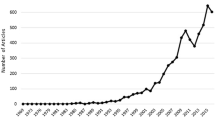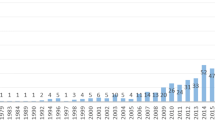Abstract
This paper discusses the mining of key nodes from the flow of knowledge in science and technology journals to technology patents at the community level. The knowledge flow network is established with spatial dimensions based on technological patent citations, scientific journals, and cooperation among researchers. The extensity centrality-Newman and commonly used degree indices are applied to isolate the nodes which occupy important positions among communities in the knowledge flow network. Suggestions are proffered accordingly to make full use of the key nodes’ roles as “bridges” to promote knowledge flow from science and technology journals to technology patents.




Similar content being viewed by others
References
Azagra-Caro, J. M., & Consoli, D. (2016). Knowledge flows, the influence of national R&D structure and the moderating role of public–private cooperation. Journal of Technology Transfer, 41(1), 152–172.
Borgatti, S. P., Everett, M. G., & Shirey, P. R. (1990). LS sets, lambda sets and other cohesive subsets. Social Networks, 12(4), 337–357.
Boyack, K. W., & Klavans, R. (2008). Measuring science–technology interaction using rare inventor–author names. Journal of Informetrics, 2(3), 173–182.
Breschi, S., & Catalini, C. (2010). Tracing the links between science and technology: An exploratory analysis of scientists’ and inventors’ networks. Research Policy, 39(1), 14–26.
Callaert, J., Grouwels, J., et al. (2012). Delineating the scientific footprint in technology: Identifying scientific publications within non-patent references. Scientometrics, 91(2), 383–398.
Callaert, J., Looy, B. V., et al. (2006). Traces of prior art: An analysis of non-patent references found in patent documents. Scientometrics, 69(1), 3–20.
Chen, L. (2017). Do patent citations indicate knowledge linkage? The evidence from text similarities between patents and their citations. Journal of Informetrics, 11(1), 63–79.
Chen, Z., & Guan, J. (2015). The core-peripheral structure of international knowledge flows: Evidence from patent citation data. R&D Management, 46(1), 62–79.
Darvish, H., & Tonta, Y. (2016). Diffusion of nanotechnology knowledge in Turkey and its network structure. Scientometrics, 107(2), 569–592.
De Sordi, J. O., Conejero, M. A., & Meireles, M. (2016). Bibliometric indicators in the context of regional repositories: Proposing the D-index. Scientometrics, 107(1), 1–24.
Ductor, L., Fafchamps, M., Goyal, S., & Leij, M. J. V. D. (2011). Social networks and research output. Review of Economics and Statistics, 96(5), 936–948.
Egghe, L. (2014). Impact coverage of the success-index. Journal of Informetrics, 8(2), 384–389.
Fatt, C. K., Ujum, E. A., & Ratnavelu, K. (2010). The structure of collaboration in the Journal of Finance. Scientometrics, 85(3), 849–860.
Finardi, U. (2011). Time relations between scientific production and patenting of knowledge: The case of nanotechnologies. Scientometrics, 89(1), 37.
Forti, E., Franzoni, C., et al. (2013). Bridges or isolates? Investigating the social networks of academic inventors. Research Policy, 42(8), 1378–1388.
Gao, X., & Guan, J. (2012). Network model of knowledge diffusion. Scientometrics, 90(3), 749–762.
Girvan, M., & Newman, M. E. J. (2001). Community structure in social and biological networks. Proceedings of the National Academy of Sciences of the United States of America, 99(12), 7821.
Giuliani, E., & Bell, M. (2005). The micro-determinants of meso-level learning and innovation: Evidence from a Chilean wine cluster. Research Policy, 34(1), 47–68.
Groh, G., & Fuchs, C. (2011). Multi-modal social networks for modeling scientific fields. New York: Springer.
Guan, J., & Liu, N. (2015). Invention profiles and uneven growth in the field of emerging nano-energy. Energy Policy, 76(1), 146–157.
Harorimana, D., & Harebamungu, M. (2013). Innovation, proximity, and knowledge gatekeepers-is proximity a necessity for learning and innovation? International Journal of Innovation and Learning, 14(2), 177–196.
Hassan, S. U., & Haddawy, P. (2013). Measuring international knowledge flows and scholarly impact of scientific research. Scientometrics, 94(1), 163–179.
Huang, M. H., Chen, S. H., Lin, C. Y., & Chen, D. Z. (2014). Exploring temporal relationships between scientific and technical fronts: A case of biotechnology field. Scientometrics, 98(2), 1085–1100.
Jansen, D., Görtz, R. V., & Heidler, R. (2010). Knowledge production and the structure of collaboration networks in two scientific fields. Scientometrics, 83(1), 219–241.
Koka, B. R., Madhavan, R., et al. (2006). The evolution of interfirm networks: Environmental effects on patterns of network change. Academy of Management Review, 31(3), 721–737.
Lai, C. H. (2015). Applying knowledge flow mining to group recommendation methods for task-based groups. Journal of the Association for Information Science and Technology, 66(3), 545–563.
Letina, S. (2016). Network and actor attribute effects on the performance of researchers in two fields of social science in a small peripheral community. Journal of Informetrics, 10(2), 571–595.
Li, H. J., Zhan, B., Li, A., Liu, Z., & Shi, Y. (2016). Fast and accurate mining the community structure: Integrating center locating and membership optimization. IEEE Transactions on Knowledge and Data Engineering, 28(9), 2349–2362.
Li, R., Chambers, T., Ding, Y., Zhang, G., & Meng, L. (2014). Patent citation analysis: Calculating science linkage based on citing motivation. Journal of the Association for Information Science and Technology, 65(5), 1007–1017.
Li, Y., Zhang, G., Feng, Y., & Wu, C. (2015). An entropy-based social network community detecting method and its application to scientometrics. Scientometrics, 102(1), 1003–1017.
Liao, C. H. (2011). How to improve research quality? Examining the impacts of collaboration intensity and member diversity in collaboration networks. Scientometrics, 86(3), 747–761.
Lin, C., Wu, J. C., & Yen, D. C. (2012). Exploring barriers to knowledge flow at different knowledge management maturity stages. Information & Management, 49(1), 10–23.
Lissoni, F. (2010). Academic inventors as brokers. Research Policy, 39(7), 843–857.
Liu, N., & Guan, J. (2015). Dynamic evolution of collaborative networks: Evidence from nano-energy research in China. Scientometrics, 102(3), 1895–1919.
Liu, X., Jiang, S., Chen, H., Larson, C. A., & Roco, M. C. (2015). Modeling knowledge diffusion in scientific innovation networks: An institutional comparison between China and US with illustration for nanotechnology. Scientometrics, 105(3), 1953–1984.
Lu, H., & Feng, Y. (2009). A measure of authors’ centrality in co-authorship networks based on the distribution of collaborative relationships. Scientometrics, 81(2), 499–511.
Newman, M. E. J. (2001a). The structure of scientific collaboration networks. Proceedings of the National Academy of Sciences of the United States of America, 98(2), 404–409.
Newman, M. E. J. (2001b). Scientific collaboration networks. II. Shortest paths, weighted networks, and centrality. Physical Review E, 64(1), 016132.
Park, H.-W., & Suh, S.-H. (2011). Scientific and technological knowledge flow and technological innovation: Quantitative approach using patent citation. In: Technology Management in the Energy Smart World.
Petruzzelli, A. M., Albino, V., et al. (2010). Leveraging learning behavior and network structure to improve knowledge gatekeepers’ performance. Journal of Knowledge Management, 14(5), 635–658.
Qu, Y., Shi, W., & Shi, X. (2015). Inferring overlapping community structure with degree-corrected block model. Physica A: Statistical Mechanics and its Applications, 419(419), 48–54.
Qu, Y., Shi, W., & Shi, X. (2017). An improved algorithm for generalized community structure inference in complex networks. Physica A: Statistical Mechanics and its Applications, 478, 41–48.
Rner, K., Dall’Asta, L., Ke, W., & Vespignani, A. (2005). Studying the emerging global brain: Analyzing and visualizing the impact of co-authorship teams: Research Articles. Complexity, 10(4), 57–67.
Roach, M., & Cohen, W. M. (2013). Lens or prism? Patent citations as a measure of knowledge flows from public research. Management Science, 59(2), 504.
Roper, S., & Hewitt-Dundas, N. (2015). Knowledge stocks, knowledge flows and innovation: Evidence from matched patents and innovation panel data. Research Policy, 44(7), 1327–1340.
Sahoo, S. (2016). Analyzing research performance: Proposition of a new complementary index. New York: Springer.
Shin, J. C., Lee, S. J., & Kim, Y. (2012). Knowledge-based innovation and collaboration: A triple-helix approach in Saudi Arabia. Scientometrics, 90(1), 311–326.
Shirabe, M. (2014). Identifying SCI covered publications within non-patent references in U.S. utility patents. Scientometrics, 101(2), 999–1014.
Sung, H. Y., Wang, C. C., Huang, M. H., et al. (2015). Measuring science-based science linkage and non-science-based linkage of patents through non-patent references. Journal of Informetrics, 9(3), 488–498.
Swedberg, R. (1995). Structural holes: The social structure of competition by Ronald S. Burt. Social Science Electronic Publishing, 42(22), 7060–7066.
Tsay, M. Y. (2015). Knowledge flow out of the domain of information science: A bibliometric and citation analysis study. Scientometrics, 102(1), 487–502.
Tutzauer, F. (2007). Entropy as a measure of centrality in networks characterized by path-transfer flow. Social Networks, 29(2), 249–265.
Verbeek, A., Debackere, K., & Luwel, M. (2003). Science cited in patents: A geographic “flow” analysis of bibliographic citation patterns in patents. Scientometrics, 58(2), 241–263.
Waltman, L., Eck, N. J. V., & Noyons, E. C. M. (2010). A unified approach to mapping and clustering of bibliometric networks. Journal of Informetrics, 4(4), 629–635.
Wang, G., & Guan, J. (2011). Measuring science-technology interactions using patent citations and author-inventor links: An exploration analysis from Chinese nanotechnology. Journal of Nanoparticle Research, 13(12), 27–42.
Wu, C. Y., & Mathews, J. A. (2012). Knowledge flows in the solar photovoltaic industry: Insights from patenting by Taiwan, Korea, and China. Research Policy, 41(3), 524–540.
Yan, E., Ding, Y., & Kong, X. (2013a). Monitoring knowledge flow through scholarly networks. Proceedings of the American Society for Information Science and Technology, 49(1), 1–5.
Yan, X., Zhai, L., & Fan, W. (2013b). C-index: A weighted network node centrality measure for collaboration competence. Journal of Informetrics, 7(1), 223–239.
Yu, G., Wang, M. Y., & Yu, D. R. (2010). Characterizing knowledge diffusion of nanoscience and nanotechnology by citation analysis. Scientometrics, 84(1), 81–97.
Zhang, G., Feng, Y., Yu, G., Liu, L., & Hao, Y. (2017a). Analyzing the time delay between scientific research and technology patents based on the citation distribution model. Scientometrics, 111, 1–20.
Zhang, G., Liu, L., Feng, Y., Shao, Z., & Li, Y. (2014). Cext-N index: A network node centrality measure for collaborative relationship distribution. Scientometrics, 101(1), 291–307.
Zhang, G., Yu, G., Feng, Y., Liu, L., & Yang, Z. (2017b). Improving the publication delay model to characterize the patent granting process. Scientometrics, 111(3), 1–17.
Zhang, Y., Kou, M., Chen, K., Guan, J., & Li, Y. (2016). Modelling the Basic Research Competitiveness Index (BR-CI) with an application to the biomass energy field. Scientometrics, 108(3), 1–21.
Zhao, Q., & Guan, J. (2012). Modeling the dynamic relation between science and technology in nanotechnology. Scientometrics, 90(2), 561–579.
Zhao, S. X., & Ye, F. Y. (2012). Exploring the directed h-degree in directed weighted networks. Journal of Informetrics, 6(4), 619–630.
Zhao, Z., Feng, S., Wang, Q., Huang, J. Z., Williams, G. J., & Fan, J. (2012). Topic oriented community detection through social objects and link analysis in social networks. Knowledge-Based Systems, 26, 164–173.
Zhou, P., & Leydesdorff, L. (2007). A comparison between the China Scientific and Technical Papers and Citations Database and the Science Citation Index in terms of journal hierarchies and inter journal citation relations. Journal of the Association for Information Science and Technology, 58(2), 223–236.
Zhou, P., Su, X., & Leydesdorff, L. (2010). A comparative study on communication structures of Chinese journals in the social sciences. Journal of the Association for Information Science and Technology, 61(7), 1360–1376.
Zhu, Y., & Yan, E. (2015). Dynamic subfield analysis of disciplines: An examination of the trading impact and knowledge diffusion patterns of computer science. Scientometrics, 104(1), 335–359.
Acknowledgements
The authors appreciate the editor and the anonymous reviewers for their insightful comments and constructive suggestions. This study was supported by National Natural Science Foundation of China (Nos. 71804091, 71701078 and 91646105). This study was also funded by Humanities and Social Sciences Foundation of the Ministry of Education of China (No. 18YJC630237). This study was also funded by a grant from the University Scientific Research Plan Projects of Shandong Province (Nos. J18KA342 and J18RA049). This study was also funded by Social Science Foundation of the University of Jinan (Nos. 18YY02 and 17YB06).
Author information
Authors and Affiliations
Corresponding authors
Rights and permissions
About this article
Cite this article
Zhang, G., Liu, L. & Wei, F. Key nodes mining in the inventor–author knowledge diffusion network. Scientometrics 118, 721–735 (2019). https://doi.org/10.1007/s11192-019-03005-2
Received:
Published:
Issue Date:
DOI: https://doi.org/10.1007/s11192-019-03005-2




